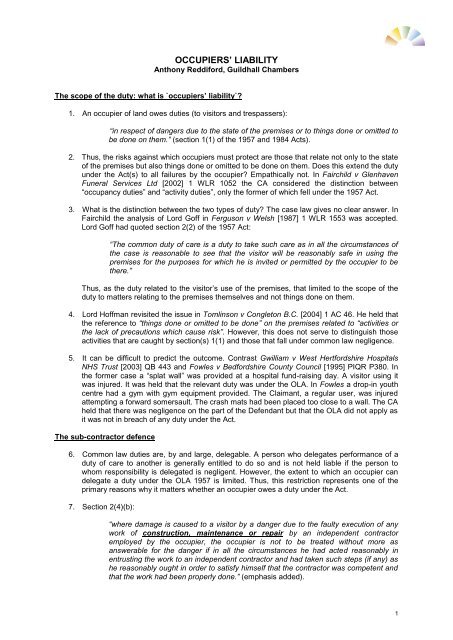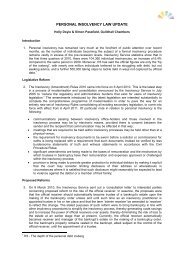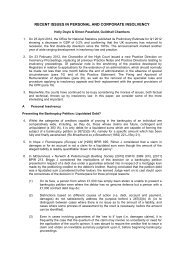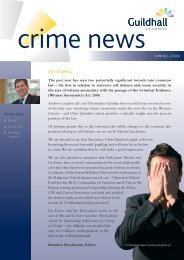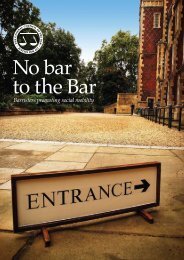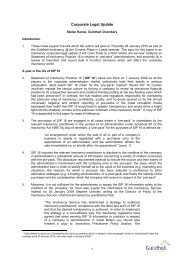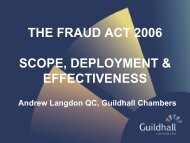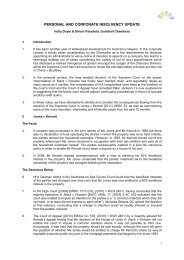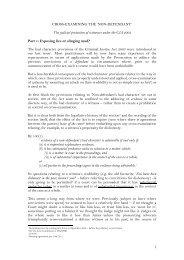OCCUPIERS' LIABILITY - Guildhall Chambers
OCCUPIERS' LIABILITY - Guildhall Chambers
OCCUPIERS' LIABILITY - Guildhall Chambers
- No tags were found...
Create successful ePaper yourself
Turn your PDF publications into a flip-book with our unique Google optimized e-Paper software.
OCCUPIERS’ <strong>LIABILITY</strong>Anthony Reddiford, <strong>Guildhall</strong> <strong>Chambers</strong>The scope of the duty: what is `occupiers’ liability`?1. An occupier of land owes duties (to visitors and trespassers):“in respect of dangers due to the state of the premises or to things done or omitted tobe done on them.” (section 1(1) of the 1957 and 1984 Acts).2. Thus, the risks against which occupiers must protect are those that relate not only to the stateof the premises but also things done or omitted to be done on them. Does this extend the dutyunder the Act(s) to all failures by the occupier? Empathically not. In Fairchild v GlenhavenFuneral Services Ltd [2002] 1 WLR 1052 the CA considered the distinction between“occupancy duties” and “activity duties”, only the former of which fell under the 1957 Act.3. What is the distinction between the two types of duty? The case law gives no clear answer. InFairchild the analysis of Lord Goff in Ferguson v Welsh [1987] 1 WLR 1553 was accepted.Lord Goff had quoted section 2(2) of the 1957 Act:“The common duty of care is a duty to take such care as in all the circumstances ofthe case is reasonable to see that the visitor will be reasonably safe in using thepremises for the purposes for which he is invited or permitted by the occupier to bethere.”Thus, as the duty related to the visitor’s use of the premises, that limited to the scope of theduty to matters relating to the premises themselves and not things done on them.4. Lord Hoffman revisited the issue in Tomlinson v Congleton B.C. [2004] 1 AC 46. He held thatthe reference to “things done or omitted to be done” on the premises related to “activities orthe lack of precautions which cause risk”. However, this does not serve to distinguish thoseactivities that are caught by section(s) 1(1) and those that fall under common law negligence.5. It can be difficult to predict the outcome. Contrast Gwilliam v West Hertfordshire HospitalsNHS Trust [2003] QB 443 and Fowles v Bedfordshire County Council [1995] PIQR P380. Inthe former case a “splat wall” was provided at a hospital fund-raising day. A visitor using itwas injured. It was held that the relevant duty was under the OLA. In Fowles a drop-in youthcentre had a gym with gym equipment provided. The Claimant, a regular user, was injuredattempting a forward somersault. The crash mats had been placed too close to a wall. The CAheld that there was negligence on the part of the Defendant but that the OLA did not apply asit was not in breach of any duty under the Act.The sub-contractor defence6. Common law duties are, by and large, delegable. A person who delegates performance of aduty of care to another is generally entitled to do so and is not held liable if the person towhom responsibility is delegated is negligent. However, the extent to which an occupier candelegate a duty under the OLA 1957 is limited. Thus, this restriction represents one of theprimary reasons why it matters whether an occupier owes a duty under the Act.7. Section 2(4)(b):“where damage is caused to a visitor by a danger due to the faulty execution of anywork of construction, maintenance or repair by an independent contractoremployed by the occupier, the occupier is not to be treated without more asanswerable for the danger if in all the circumstances he had acted reasonably inentrusting the work to an independent contractor and had taken such steps (if any) ashe reasonably ought in order to satisfy himself that the contractor was competent andthat the work had been properly done.” (emphasis added).1
8. Given that an occupier can owe duties to visitors that go well beyond the state of the fabric ofthe premises, can an occupier only avoid liability for delegating works of “Construction,maintenance or repair”? The editors of Clerk & Lindsell believe not (paragraph 12-56):“`Construction, maintenance or repair` covers almost all conceivable works on land orstructures, including demolition. Even if it were possible to conceive of somenegligence by an independent contractor that was not directly covered by thesewords, it is suggested that the courts would apply the section expansively, as clearlyintended to oust any occupier’s liability for independent contractors...”.9. It is not difficult to conceive of some negligence by an independent contractor that is notdirectly covered by these words. For example, the company that erected the “splat wall” inGwilliam. So would the words of s. 2(4)(b) be stretched to cover such situations?10. All the authorities suggest not. In Stone v Taffe [1974] 1 WLR 1575 the occupiers of a pubwho had an independent manager ,who let customers stay and drink “after hours”, were held(obiter) not to be able to rely on the sub-contractor defence as the manager’s actions did notfall within the subsection.11. In Ferguson v Welsh [1987] 1 WLR 1553 the House of Lords were prepared to stretch thephrase “construction, maintenance or repair” to cover demolition work. They did so in termsthat suggested that they thought the meaning of the words was being stretched to do so. Ifthat is right, then works that are nothing to do with “building work” are unlikely to be covered.12. Finally, in Gwilliam (the splat wall case), the CA refused to extend s. 2(4) to contractors whoran the “splat wall”.13. Thus, perhaps contrary to widespread belief, the scope of the sub-contractor defence in s.2(4) is of relatively narrow ambit.The nature of the duty14. Closely allied to the issue of the scope of the duty is the nature of the duty owed. InTomlinson Lord Hoffman emphasised that the premises that must be dangerous. If Claimant’schose to do dangerous things on safe premises, they cannot expect to succeed. There arenumerous “diving” cases that illustrate the point that the premises have to be shown to beunsafe. Thus:Ratcliff v McConnell [1999] 1 WLR 670A student diving into a college pool at a time when it was shut failed (under the 1984 Act)because the pool was not of an unsafe configuration.Tomlinson v CongletonA young man dived into a lake and struck his head on the shallow bottom of the lake,breaking his neck. Although swimming was prohibited (for reasons other than the risk ofdiving), the lake was not inherently dangerous or unusual. The claim failed (again under the1984 Act).Baldacchino v West Wittering Estate PLC EWHC 3386 (QB)A 14-year-old boy dived from a navigation beacon into the sea and suffered serious injury. Hisclaim (under the 1984 Act) failed because the beacon was not unsafe – the activity for divinginto the sea from it was.Grimes v Hawkins [2011] EWHC 2004 (QB)An 18-year old girl at a house party dived into the family swimming pool and struck her headon the bottom of the shallow end. There were no warning signs against diving. However, thepool was not of an unusual configuration and was not dangerous. The claim failed.15. Perhaps the case that most vividly demonstrates the principle is:Geary v JD Wetherspoon PLC [2011] EWHC 1506 (QB)2
An historic building had been refurbished to become a pub. It had a long sweeping staircasewith an original banister. The Claimant decided to slide down it. She fell off the bottom onto amarble floor and suffered injury. The Court held that it was the activity of sliding and not thebanister itself that was unsafe (even though the Defendant had foreseen that customers mightslide down it).16. These cases all illustrate that the premises themselves must be shown to be unsafe and notmerely that an unsafe activity has been undertaken on premises that are otherwise safe. Thetest for what is dangerous is relatively tolerant to the idiosyncrasies of the premises.17. In many of the cases, the fact that the Claimant was guilty of some form of misconduct seemsto have been persuasive, whether of not the Claimant was a trespasser and thereforeclaiming under the 1984 Act or a visitor, under the 1957 Act.Anthony Reddiford<strong>Guildhall</strong> <strong>Chambers</strong>June 2013The material contained in this article is provided for general information purposes only. It does not constitute legal or otherprofessional advice. No responsibility is assumed by any member of chambers for its accuracy or currency, and reliance shouldnot be placed upon it. Specific, personal legal advice should be obtained in relation to any case or matter. Any views expressedare those of the editor or named author.3


